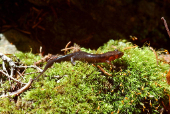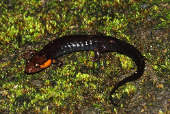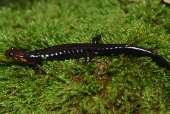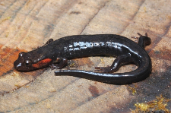Imitator Salamander (Desmognathus imitator)
Description: The imitator salamander is dark brown or blackish, sometimes with a pale intermittent stripe down its back and a pale line joining eye to jaw. It often has red or orange cheek patches and its hind legs are more stocky than its forelegs.
Habitat: Its habitat is the banks of streams, wet rocks, and the forest floor at higher altitudes. It shares its range with the Ocoee salamander (Desmognathus ocoee) but is usually found closer to water.
Range: The imitator salamander is found in the Appalachian Mountains in Tennessee and North Carolina at elevations more than 900 m (3,000 ft) above sea level. Its range extends from the Great Smoky Mountains in the north to the Plott Balsams and the Great Balsam Mountains in the south.
Found in these States:
NC |
TN
Diet: Adult imitator salamanders hide during the day and emerge at night to forage for small invertebrates.
Reproduction: The imitator salamander breeds in summer, and a clutch of about 20 eggs is laid and attached to the underside of a rock in a seepage or other wet location. The female broods the eggs, and when they hatch the larvae may live among wet moss, under rocks and among leaf litter. Little is known of their development, but they are assumed to eat small invertebrates and undergo metamorphosis into juveniles around 10 months old.
Status: The species' extent of occurrence (EOO) is 4,504 km2 and there is continuing decline in the extent and quality of its habitat outside of protected areas. However its population is not severely fragmented, and the majority of its range is not threatened, hence the subcriteria that refers to locations is not currently met. It is therefore close to qualifying for Vulnerable under criterion B1 and is listed as Near Threatened.
»» Kingdom: Animalia - Animals
»» Phylum: Chordata - Chordates
»» Subphylum: Vertebrata - Vertebrates
»» Class: Amphibia - (Amphibians)
»» Order: Caudata - Salamanders
»» Family: Plethodontidae - Lungless Salamanders
»» Genus: Desmognathus
»» Species: Desmognathus imitator - Imitator Salamander
This article uses material from the Wikipedia article "Imitator Salamander", which is released under the Creative Commons Attribution-Share-Alike License 3.0. Content may have been omitted from the original, but no content has been changed or extended.
|













